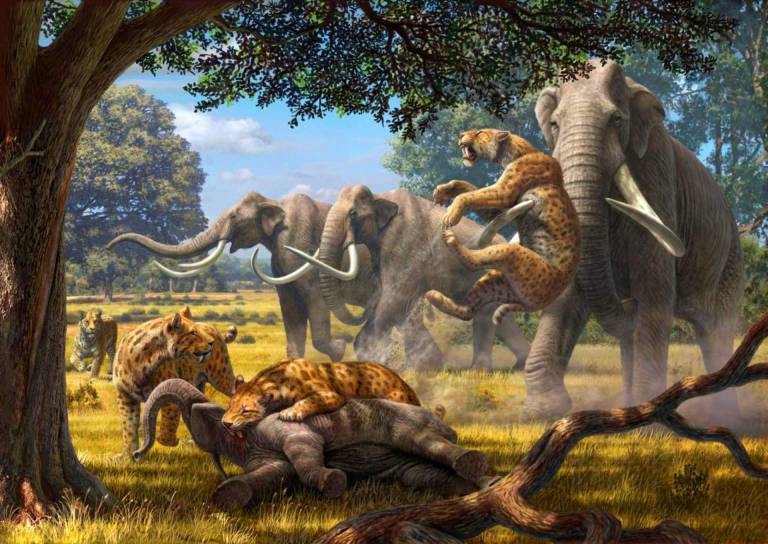Serengeti had more large-bodied mammals over 300kg in the Pleistocene than today
6 December 2017
Eight years of excavation work by the Olduvai Geochronology and Archaeology Project (OGAP) has produced a rich vertebrate fauna from several sites within Bed II, Olduvai Gorge, Tanzania.
 Study of these as well as recently re-organized collections from Mary Leakey's 1972 HWK EE excavations here provides a synthetic view of the faunal community of Olduvai during Middle Bed II at ∼1.7-1.4 Ma, an interval that captures the local transition from Oldowan to Acheulean technology. We expand the faunal list for this interval, name a new bovid species, clarify the evolution of several mammalian lineages, and record new local first and last appearances. Compositions of the fish and large mammal assemblages support previous indications for the dominance of open and seasonal grassland habitats at the margins of an alkaline lake. Fish diversity is low and dominated by cichlids, which indicates strongly saline conditions. The taphonomy of the fish assemblages supports reconstructions of fluctuating lake levels with mass die-offs in evaporating pools. The mammals are dominated by grazing bovids and equids. Habitats remained consistently dry and open throughout the entire Bed II sequence, with no major turnover or paleoecological changes taking place. Rather, wooded and wet habitats had already given way to drier and more open habitats by the top of Bed I, at 1.85-1.80 Ma. This ecological change is close to the age of the Oldowan-Acheulean transition in Kenya and Ethiopia, but precedes the local transition in Middle Bed II.
Study of these as well as recently re-organized collections from Mary Leakey's 1972 HWK EE excavations here provides a synthetic view of the faunal community of Olduvai during Middle Bed II at ∼1.7-1.4 Ma, an interval that captures the local transition from Oldowan to Acheulean technology. We expand the faunal list for this interval, name a new bovid species, clarify the evolution of several mammalian lineages, and record new local first and last appearances. Compositions of the fish and large mammal assemblages support previous indications for the dominance of open and seasonal grassland habitats at the margins of an alkaline lake. Fish diversity is low and dominated by cichlids, which indicates strongly saline conditions. The taphonomy of the fish assemblages supports reconstructions of fluctuating lake levels with mass die-offs in evaporating pools. The mammals are dominated by grazing bovids and equids. Habitats remained consistently dry and open throughout the entire Bed II sequence, with no major turnover or paleoecological changes taking place. Rather, wooded and wet habitats had already given way to drier and more open habitats by the top of Bed I, at 1.85-1.80 Ma. This ecological change is close to the age of the Oldowan-Acheulean transition in Kenya and Ethiopia, but precedes the local transition in Middle Bed II.
The Middle Bed II large mammal community is much richer in species and includes a much larger number of large-bodied species (>300 kg) than the modern Serengeti. This reflects the severity of Pleistocene extinctions on African large mammals, with the loss of large species fitting a pattern typical of defaunation or 'downsizing' by human disturbance. However, trophic network (food web) analyses show that the Middle Bed II community was robust, and comparisons with the Serengeti community indicate that the fundamental structure of food webs remained intact despite Pleistocene extinctions. The presence of a generalized meat-eating hominin in the Middle Bed II community would have increased competition among carnivores and vulnerability among herbivores, but the high generality and interconnectedness of the Middle Bed II food web suggests this community was buffered against extinctions caused by trophic interactions. Ignacio de la Torre of the UCL Institute of Archaeology was part of the research team.
Paleoecology of the Serengeti during the Oldowan-Acheulean transition at Olduvai Gorge, Tanzania: The mammal and fish evidence
Faysal Bibi, Michael Pante, Antoine Souron, Kathlyn Stewart, Sara Varela, Lars Werdelin, Jean-Renaud Boisseri, Mikael Fortelius, Leslea Hlusko, Jackson Njau, Ignacio de la Torre
DOI: 10.1016/j.jhevol.2017.10.009
 Close
Close

